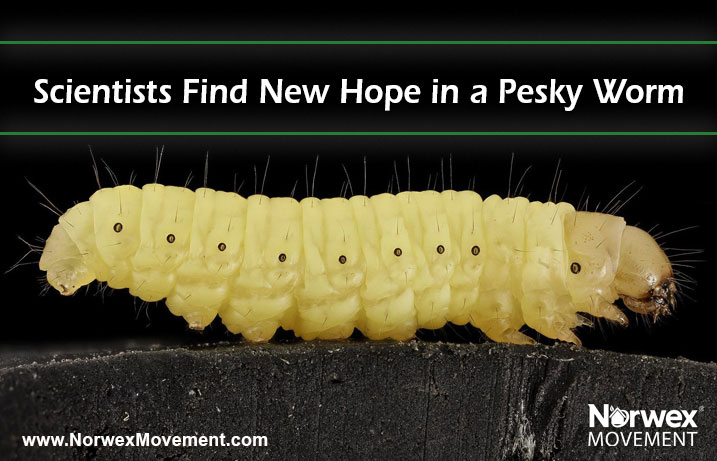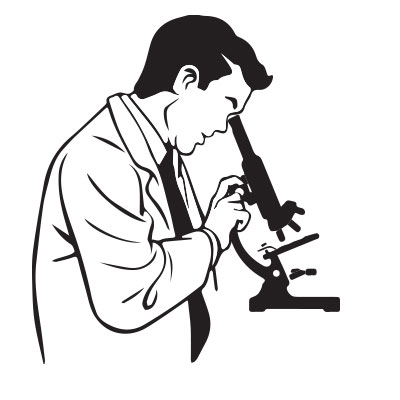

It sounds a little like the plot from an old horror movie—Monster Worms Devour Everything!
Well, not quite everything. This worm actually prefers feasting on yummy beeswax to human flesh. You see, the larvae of the wax moth normally live on beeswax. This insatiable craving has made them enemy #1 for most beekeepers.
But a chance discovery has revealed this worm also has a taste for more than just wax. They enjoy noshing on plastic! And so, this revelation may offer a way to make plastic waste biodegradable.
It all started when Dr. Federica Bertocchini, a researcher at the Spanish National Research Council, and scientists at Cambridge University removed an infestation of the worms from one of her beehives. After getting them out of her hive, she put them aside in a plastic bag. Later, she returned to make a shocking discovery—the worms had eaten their way out of the plastic bag!
This led Bertocchini to investigate the feeding habits of the worms. In lab tests, she found that 100 worms can consume up to 92 milligrams (about the size of two aspirin) of polyethylene in as little as 12 hours. With such a voracious appetite, these little worms could be put to good use gorging on plastic waste.
Paolo Bombelli, a biochemist at Cambridge who also took part in the study, said these findings could lead to a potential solution to the plastic waste that is mounting up in our waterways, oceans and landfills.
One possible way to reduce the plastic waste could be to breed large enough numbers of the worms and just turn them loose on the plastic. But this solution may be viable only if the worms have an endless appetite for plastic.
“We want to know if they’re munching the plastic to use as a food, or just because they want to escape,” said Bombelli. “If they just want to escape, they are going to get fed up very soon. But if they’re munching it to use as an energy source it’s a completely different ball game. We are not yet able to answer this, but we’re working on it.”
Bertocchini and Bombelli hope their findings might help make plastics biodegradable in landfills, as well as those scattered throughout our oceans.

Polyethylene is one of the most commonly used plastics globally. Each year, the average person uses more than 200 plastic bags, which can take between 100 and 400 years to degrade in landfill sites.
In the oceans, plastic waste breaks down into small particles, which pose a serious health risk to the fish that ingest them. Each year, some eight million tons of plastic waste plastic from around the world ends up in the ocean.
 Scientists are continuously searching for ways to break down plastics. Find out what other research is being is being done today.
Scientists are continuously searching for ways to break down plastics. Find out what other research is being is being done today.
Resources:
My only concern is if it takes 100 of these worms to eat 92 milligrams, how many will be produced to help make a difference in our landfills and oceans? Could we not end up with an infestation of them?
Great question, Diane! Hopefully, scientists will take that possibility into consideration.
But then, wouldn’t we be overcome with that many more moths?
How amazing!
This has possibly disastrous effects on our food chain. Wax moths are a serious threat to beehives. OVER one-third of ALL sources of food in the US depend on bees for pollination. By artificially increasing the population of this known “pest” to help solve one problem, we may in turn create an even bigger one. Cautious research is needed. Does anybody remember what problem was the introduction of the gypsy moth to the US supposed to fix?
good point
I get the whole excitement of these worms eating plastic and wouldn’t that be great, but then we have the problem of controlling these guys after they are done eating. Do we really want to upset the balance of the eco-system by breeding large numbers? Look what is happening with the Asian Lady Beetles in the Midwest, the Emerald Ash Borer, the Brown Tree Snake, and I could go on. Do we really want to mess with nature just to clean up our mess?
We agree with you Amy and Mark that more cautious research is definitely needed! Thank you for your comments.
I have heard of these worms that eat plastic.. I, too, wonder what may happen if the wax moth population ends up out of control. On a side note, I thought that I may have read something somewhere about a bacteria that “eats”plastic. I do hope that further discoveries are made to eliminate plastics. Would the elimination of plastics not eliminate Norwex products, though?
I am amazed at how long it takes for plastic bags to break down. All the more reason to use reusable options!
Since our bees are already under a global threat from pesticides, we don’t need to add an additional threat to their existence. Moths fly where they want and lay eggs where they want…so watch out beehives! Too much risk for my liking.
I’m not sure I agree with breeding large amounts of these worms. I worry about the over population of these insects and how they would be controlled, how this would effect our environment and more. A lot more research needs to be done.
I agree we need to find a solution to our pollution problem, but we need to stop it at the source by getting people to change their habits.
My thoughts exactly Diane. As a society we’ve used animals to solve a problem and they then become a problem that needs to be solved. Until we know long term impact on the ecosystem, we should hold off.
Messing with the environment to clean up our mess usually doesn’t work out well.
This is very interesting…. let’s keep researching! where there is a will there is a way!!
I think the idea is fascinating, but I agree with the other comments about a LOT of careful research being needed. If this becomes a viable option, I wonder if controlled environments could be created–a worm recycling center, if you will–rather than artificially creating an overpopulation of a potentially huge threat to our ecosystem. Introducing a foreign species or artificially bloating a population of any animal can be disastrous to an ecosystem.
This is so fascinating! I would love to follow this story to see what they discover.. I hope they are going after the plastic for food!!